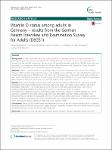Vitamin D status among adults in Germany – results from the German Health Interview and Examination Survey for Adults (DEGS1)
Rabenberg, Martina
Scheidt-Nave, Christa
Busch, Markus A.
Rieckmann, Nina
Hintzpeter, Birte
Mensink, Gert
Background: In 1998, more than half of the adult population in Germany had serum 25-hydroxy-vitamin-D [25(OH)D] levels below the common threshold of 50 nmol/l. Since then, there has been a lot of attention for vitamin D in the scientific community, the media and the general population and serum 25(OH)D levels may have increased as a consequence. With data from the ‘German Health Interview and Examination Survey for Adults’ (DEGS1) the current situation of vitamin D status can be analysed. Methods: DEGS1, a national health survey among adults in Germany conducted by the Robert Koch Institute between 2008 and 2011, included 6,995 persons with available serum 25(OH)D levels. We calculated the proportion of participants with serum 25(OH)D levels =50 nmol/l overall and according to age, season and latitude of residence as well as percentiles of serum 25(OH)D according to month of examination. Determinants of vitamin D status were analysed with multiple linear regression models. Results: Mean serum 25(OH)D level was 45.6 nmol/l with no significant sex differences (p = 0.47). 61.6 % of the participants had serum 25(OH)D levels

